 The March
The March
I woke at 1:30 Sunday morning to hit the porta potties. The air was
cold, but not too bad. I though, I could handle this. The stars
were beautiful. I fell back asleep until my portable clock woke me up at
3:45. I seemed to be the only one awake. I had already set out the clothes
I'd wear on the march. I tried to keep it simple: BDU pants, khaki BDU
shirt (I look good in khaki because I'm an autumn), t-shirt, boonie
hat, bandanna. I wore the cross-training shoes I'd been practicing in.
Clipped to my belt was my Swiss Army knife, my watch, a pen light and my
dust goggles. Into the pockets went sunscreen, foot powder, digital camera,
extra batteries and extra socks. I put off putting my medallion around
my neck, but I went ahead and put it on. I have to finish the
March now, I thought. I had considered taking the 35mm along with the
digital camera, but decided to leave the 35mm behind. It would have been
just one more thing to carry. I wished I'd brought tube socks instead of
crew socks.
 I set off walking down the street towards the Officer's Club, where everything
would start. Ahead, I could see a long line of headlights as cars made
their way onto the base. Cops directed them to parking places in a big
field. I guessed they were people coming to see the March. I asked a traffic
cop if I was going in the right direction. "Just follow the noise," he
advised. I walked past the RV parking and followed the music. I walked
through another crowded lot of cars to the Officer's Club, which had big
speakers playing rock music. Big spotlights illuminated tents where "breakfast"
was being handed out. I got an orange, a banana, and an elementary school-sized
carton of orange juice; mine had ice crystals in it. I sat at a table with
a nice couple from Colorado. When I said I spent Friday night in Roswell,
the lady said, "Roswell's a funny little town." As they got up to leave,
they told me, "Take care of yourself." It was still pitch dark out. It
was cold, but any kind of breeze made me glad I was wearing long sleeves.
"If the wind stays like this," one cop said, "we'll be okay."
I set off walking down the street towards the Officer's Club, where everything
would start. Ahead, I could see a long line of headlights as cars made
their way onto the base. Cops directed them to parking places in a big
field. I guessed they were people coming to see the March. I asked a traffic
cop if I was going in the right direction. "Just follow the noise," he
advised. I walked past the RV parking and followed the music. I walked
through another crowded lot of cars to the Officer's Club, which had big
speakers playing rock music. Big spotlights illuminated tents where "breakfast"
was being handed out. I got an orange, a banana, and an elementary school-sized
carton of orange juice; mine had ice crystals in it. I sat at a table with
a nice couple from Colorado. When I said I spent Friday night in Roswell,
the lady said, "Roswell's a funny little town." As they got up to leave,
they told me, "Take care of yourself." It was still pitch dark out. It
was cold, but any kind of breeze made me glad I was wearing long sleeves.
"If the wind stays like this," one cop said, "we'll be okay."
There were people wearing every kind of military fatigues all over,
checking their packs, grabbing a bite to eat, or catching some extra sleep.
There were individual and team divisions where you could do the March carrying
a 35-pound pack. I walked around, trying to keep warm. The generators
running the spotlights offered a little heat, if you didn't mind breathing
the exhaust. I sat back down with a couple of brothers from Boston named
Mike and Phil. It turned out their mother lived in Tulsa. They were waiting
for their brother to join them. They spent the night in Las Cruces and
drove in about 2 AM. It looked like a lot of people did that.
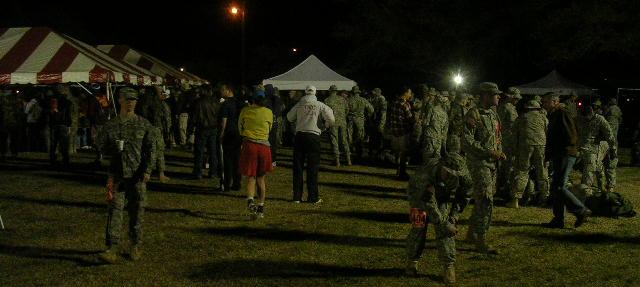 Two friends met out on the lawn: "Ready to rock and roll?" one asked.
"Hooah!" the other replied. The lines were 10-deep at the porta
potties; I was glad I went earlier. A group of bagpipers were playing near
the grandstand. I smiled when they played "Highland Cathedral." That's
how I knew everything was going to be okay. Pedestrian fences were set
up in the parking lot, marking off the groups everyone was assigned to.
High above, probably the biggest American flag I'd ever seen hung off a
tall crane. Lots of folks were taking pictures. My BDU shirt had patches
from various national parks I'd visited. One lady liked my patches. She
told me her 15-year-old son had made the March the year before. It took
him 11 hours to finish, "pretty much all day," but he indeed finished,
and was back to do it again. When I said I was going to try to make it,
she looked at me and said, confidently, "You will."
Two friends met out on the lawn: "Ready to rock and roll?" one asked.
"Hooah!" the other replied. The lines were 10-deep at the porta
potties; I was glad I went earlier. A group of bagpipers were playing near
the grandstand. I smiled when they played "Highland Cathedral." That's
how I knew everything was going to be okay. Pedestrian fences were set
up in the parking lot, marking off the groups everyone was assigned to.
High above, probably the biggest American flag I'd ever seen hung off a
tall crane. Lots of folks were taking pictures. My BDU shirt had patches
from various national parks I'd visited. One lady liked my patches. She
told me her 15-year-old son had made the March the year before. It took
him 11 hours to finish, "pretty much all day," but he indeed finished,
and was back to do it again. When I said I was going to try to make it,
she looked at me and said, confidently, "You will."
At 6:15, there was an announcement for people to start gathering in
the starting areas. The eastern sky was just starting to brighten. Lots
of the civilians had done other marathons all over the country. One girl
talked about doing the New Orleans Mardi Gras Marathon, and commented,
"You don't wanna smell Bourbon Street first thing in the morning!"
Another girl had a red teddy bear attached to her backpack.
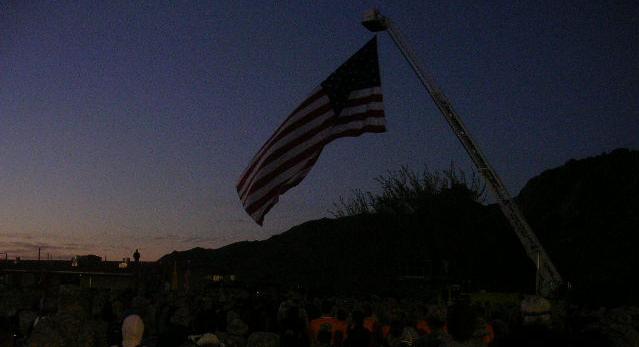 I spoke to a couple from Arizona. It was the man's 5th time do the March.
"Waiting is the hardest part," he told me, as we waited in the gathering
light. He said when he first came to White Sands, they had 20 Bataan survivors
show up. That year, there were only three. He was doing the March, while
his wife waited behind for him. He wished me luck. Finally, about 6:30,
the speeches started. They did a roll call of Bataan survivors that were
present, and for those no longer with us. The commanding general welcomed
us all to the March, civilian and military alike, and predicted, "It
will change you." There were 5,300 people waiting to do the
March, about a thousand more than the previous year. All 50 states were
represented, as well as Puerto Rico, several foreign countries... and Guantanamo
Bay. Just as the Sun was coming up, two jet fighters from Holloman AFB
did a fly-over, and it was pretty dramatic. "Those suckers are big,
too!" one person yelled.
I spoke to a couple from Arizona. It was the man's 5th time do the March.
"Waiting is the hardest part," he told me, as we waited in the gathering
light. He said when he first came to White Sands, they had 20 Bataan survivors
show up. That year, there were only three. He was doing the March, while
his wife waited behind for him. He wished me luck. Finally, about 6:30,
the speeches started. They did a roll call of Bataan survivors that were
present, and for those no longer with us. The commanding general welcomed
us all to the March, civilian and military alike, and predicted, "It
will change you." There were 5,300 people waiting to do the
March, about a thousand more than the previous year. All 50 states were
represented, as well as Puerto Rico, several foreign countries... and Guantanamo
Bay. Just as the Sun was coming up, two jet fighters from Holloman AFB
did a fly-over, and it was pretty dramatic. "Those suckers are big,
too!" one person yelled.
 The Sun poked over the horizon right at 7 AM. At 7:20, a cannon boomed
into the air. "Here we go," someone said. We all moved out towards
the starting line, all five thousand of us. Just as I crossed the starting
line, the loudspeakers started playing the theme to "Rocky." There was
a bottleneck as marchers stopped to shake the hands of veterans on the
sidelines, but I just waved. I didn't want to hold up the people behind
me. The March had started!
The Sun poked over the horizon right at 7 AM. At 7:20, a cannon boomed
into the air. "Here we go," someone said. We all moved out towards
the starting line, all five thousand of us. Just as I crossed the starting
line, the loudspeakers started playing the theme to "Rocky." There was
a bottleneck as marchers stopped to shake the hands of veterans on the
sidelines, but I just waved. I didn't want to hold up the people behind
me. The March had started!
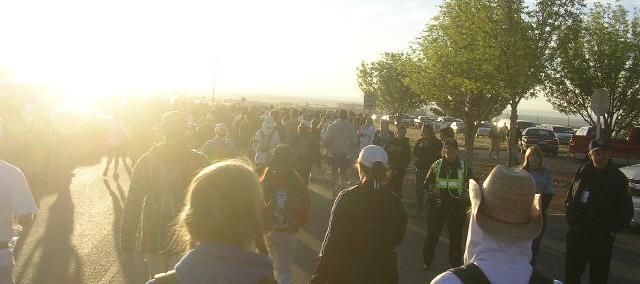 We took off eastward towards the rising Sun, down the flat, even streets
of the base. I started off at a pretty good pace, I thought. I kept checking
my watch to note my time. It was a beautiful day for a walk: no wind, no
clouds, the air crisp and clean. Runners were passing me on all sides.
I wasn't in a race; I just wanted to finish, to go the distance. we passed
a weather station, high on a pole. I reached the 1 mile marker at 7:45.
I tried to keep pace with a guy ahead of me, carrying a full 35- pound
pack and walking along with someone I presumed was his girlfriend. I decided
to walk at my own pace and not someone else's. He soon disappeared ahead
in the crowd. A dozen guys in fatigues and full packs trotted past me.
We took off eastward towards the rising Sun, down the flat, even streets
of the base. I started off at a pretty good pace, I thought. I kept checking
my watch to note my time. It was a beautiful day for a walk: no wind, no
clouds, the air crisp and clean. Runners were passing me on all sides.
I wasn't in a race; I just wanted to finish, to go the distance. we passed
a weather station, high on a pole. I reached the 1 mile marker at 7:45.
I tried to keep pace with a guy ahead of me, carrying a full 35- pound
pack and walking along with someone I presumed was his girlfriend. I decided
to walk at my own pace and not someone else's. He soon disappeared ahead
in the crowd. A dozen guys in fatigues and full packs trotted past me.
 We turned north, and a guy next to me was searching along the course for
a place where he could turn off and pee. At 8 AM we hit the mile 2 water
station (each one had porta potties) and took a dirt road out into the
desert. There were volunteers handing out cups of water and Gatorade. Someone
behind me whined, "Are we there yet?" His friend laughed and said,
“There’s one in every crowd!” The dirt road had areas of sandy soil I had
to watch out for. At 8:15 I hit the 3 mile mark. I was keeping a pretty
even pace, so far. The field was still pretty crowded. Along the route,
volunteers on 4-wheel ATV's zoomed up and down the line of marchers, looking
for any problems. One guy stepped off the course to catch his breath; it
looked like a guy in an air cavalry hat was helping him. A troop of ROTC
cadets marched past me, singing Christmas carols as a marching cadence.
We turned north, and a guy next to me was searching along the course for
a place where he could turn off and pee. At 8 AM we hit the mile 2 water
station (each one had porta potties) and took a dirt road out into the
desert. There were volunteers handing out cups of water and Gatorade. Someone
behind me whined, "Are we there yet?" His friend laughed and said,
“There’s one in every crowd!” The dirt road had areas of sandy soil I had
to watch out for. At 8:15 I hit the 3 mile mark. I was keeping a pretty
even pace, so far. The field was still pretty crowded. Along the route,
volunteers on 4-wheel ATV's zoomed up and down the line of marchers, looking
for any problems. One guy stepped off the course to catch his breath; it
looked like a guy in an air cavalry hat was helping him. A troop of ROTC
cadets marched past me, singing Christmas carols as a marching cadence.
 With the Sun up, it was quickly getting warm. I took off the bandana around
my neck. A pair of girls behind me were refreshing themselves with some
baby wipes. "Anybody else need a wipe?" one asked. A group in green fatigues
passed me, following a guy hauling a double-sized backpack. He seemed to
be carrying the whole team's stuff. "O-tay?" the leader asked.
"O-tay!" they said. I hit mile 4 at 8:31, still keeping a steady pace.
The air was thick with the sounds of hundreds of feet crunching over gravel
and packed earth. A group of guys in desert camos marched past me; by their
accents, I think they were British soldiers. "Keep it slow," one of them
said. Three marchers in Border Patrol shirts were right behind them.
With the Sun up, it was quickly getting warm. I took off the bandana around
my neck. A pair of girls behind me were refreshing themselves with some
baby wipes. "Anybody else need a wipe?" one asked. A group in green fatigues
passed me, following a guy hauling a double-sized backpack. He seemed to
be carrying the whole team's stuff. "O-tay?" the leader asked.
"O-tay!" they said. I hit mile 4 at 8:31, still keeping a steady pace.
The air was thick with the sounds of hundreds of feet crunching over gravel
and packed earth. A group of guys in desert camos marched past me; by their
accents, I think they were British soldiers. "Keep it slow," one of them
said. Three marchers in Border Patrol shirts were right behind them.
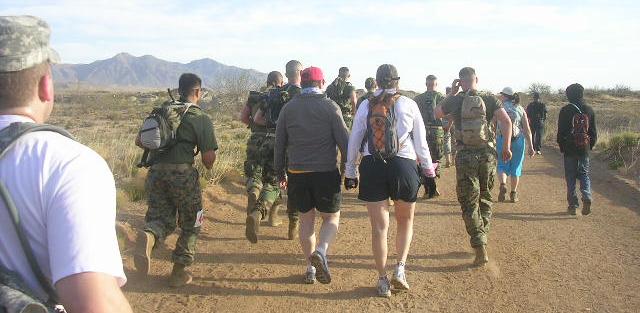 The road angled slightly uphill after mile 5, then followed a line of telephone
poles through the arid landscape. I still felt pretty good, not yet winded.
I rewarded my progress with a peppermint. I'd brought five hard candies
to reward each five-mile point. The candy kept my mouth moist and gave
me something to think about. The ground was still mostly solid underfoot.
Off to the left, I could see trucks going down Highway 70. I hit mile 6
just after 9 AM.
The road angled slightly uphill after mile 5, then followed a line of telephone
poles through the arid landscape. I still felt pretty good, not yet winded.
I rewarded my progress with a peppermint. I'd brought five hard candies
to reward each five-mile point. The candy kept my mouth moist and gave
me something to think about. The ground was still mostly solid underfoot.
Off to the left, I could see trucks going down Highway 70. I hit mile 6
just after 9 AM.
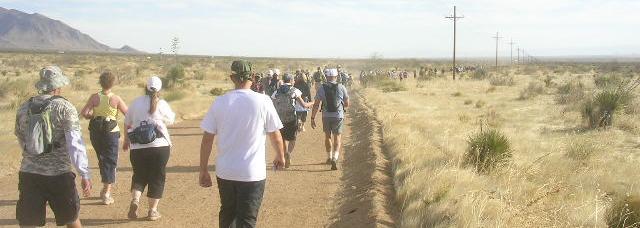 The desert flattened out some. I rolled up the sleeves of my BDU and slipped
on some sunblock. I bought the smallest bottle of sunblock I could find,
but it still seemed too big to bring along, so I found a little squirt
bottle at the dollar store and put in just enough sunblock that I’d need
for the March. There was a 4-foot brunette girl in front of me with a red
Camelbak. I'd be walking behind her, and eventually catch up to her, but
then she'd take off running for a minute and be back in front of me again.
At the next water station, I took a drink of Gatorade and helped myself
to an orange slice.
The desert flattened out some. I rolled up the sleeves of my BDU and slipped
on some sunblock. I bought the smallest bottle of sunblock I could find,
but it still seemed too big to bring along, so I found a little squirt
bottle at the dollar store and put in just enough sunblock that I’d need
for the March. There was a 4-foot brunette girl in front of me with a red
Camelbak. I'd be walking behind her, and eventually catch up to her, but
then she'd take off running for a minute and be back in front of me again.
At the next water station, I took a drink of Gatorade and helped myself
to an orange slice.
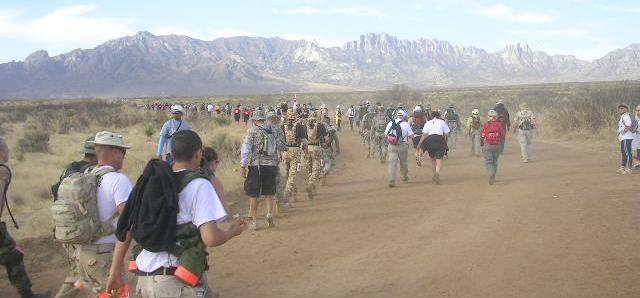 The trail took a turn back south before heading west in a slight upward
grade. At mile 7, a marine took a step off the trail to give the mileage
sign a tap before trotting away. I'll bet he did that with all of
the signs. A soldier in a full Alice pack marched past me, the pack creaking
a chicka-bop chicka-bop rhythm as he walked.
The trail took a turn back south before heading west in a slight upward
grade. At mile 7, a marine took a step off the trail to give the mileage
sign a tap before trotting away. I'll bet he did that with all of
the signs. A soldier in a full Alice pack marched past me, the pack creaking
a chicka-bop chicka-bop rhythm as he walked.
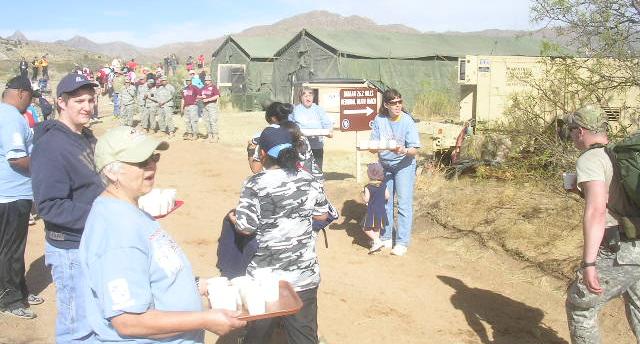 Just past mile 8 was a medic station. It was alongside the road leading
from the highway to the base. They had a tent with cots for people that
were worn out. Volunteers handed out water and encouragement. That's where
I got a drink of water and took my lone pit stop of the March. That was
also where the Blue Route, the shorter, honorary March, turned back towards
the base.
Just past mile 8 was a medic station. It was alongside the road leading
from the highway to the base. They had a tent with cots for people that
were worn out. Volunteers handed out water and encouragement. That's where
I got a drink of water and took my lone pit stop of the March. That was
also where the Blue Route, the shorter, honorary March, turned back towards
the base.
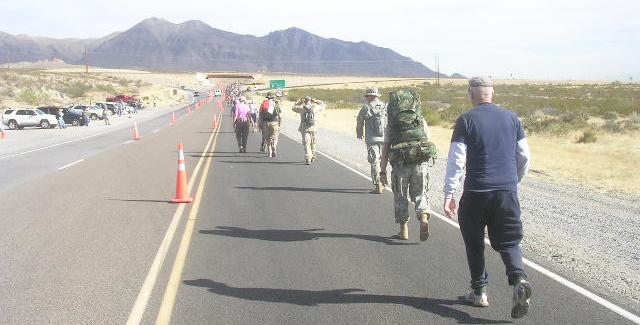 For the rest of us, we headed northward towards the interstate. As I reached
the pavement, someone cried, "Runner!" A marcher was running down the road
in the opposite direction. He had run the whole northern loop of the marathon
and was already on his way to the finish line! The trail took us
under the overpass and up an access road. And when I say up, I mean uphill
all the way. The road was firm pavement, just a constant uphill
grade for about three miles. It seemed to just go on and on. A couple more
runners came down the hill headed for the finish. Everyone applauded as
they went by.
For the rest of us, we headed northward towards the interstate. As I reached
the pavement, someone cried, "Runner!" A marcher was running down the road
in the opposite direction. He had run the whole northern loop of the marathon
and was already on his way to the finish line! The trail took us
under the overpass and up an access road. And when I say up, I mean uphill
all the way. The road was firm pavement, just a constant uphill
grade for about three miles. It seemed to just go on and on. A couple more
runners came down the hill headed for the finish. Everyone applauded as
they went by.
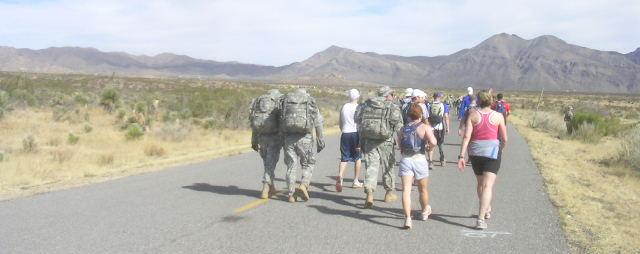 I hit mile 9 just before 10 AM. Up ahead, trucks had been set up to spray
water across the road for marchers. I got some water and an orange slice
at the med station. The sprayed water was refreshing, but the road kept
going uphill. I was sure I'd passed the 10 mile mark when a soldier with
a GPS said no, it was just mile 9.3. I thought I was a lot further along
than that. I passed one army reservist who seemed to be huffing and puffing
as he trudged along. "You okay?" I asked. He nodded yes, adding, "I'm
just feeling my 25 years catching up to me." I said, "Well, I'm 52,
and I made it this far." He grunted "Huh," and soon picked up his
pace. It was 10:30 when I found the 11 mile marker. By that time, I was
sucking air, just putting one foot in front of the other.
I hit mile 9 just before 10 AM. Up ahead, trucks had been set up to spray
water across the road for marchers. I got some water and an orange slice
at the med station. The sprayed water was refreshing, but the road kept
going uphill. I was sure I'd passed the 10 mile mark when a soldier with
a GPS said no, it was just mile 9.3. I thought I was a lot further along
than that. I passed one army reservist who seemed to be huffing and puffing
as he trudged along. "You okay?" I asked. He nodded yes, adding, "I'm
just feeling my 25 years catching up to me." I said, "Well, I'm 52,
and I made it this far." He grunted "Huh," and soon picked up his
pace. It was 10:30 when I found the 11 mile marker. By that time, I was
sucking air, just putting one foot in front of the other.
 The long uphill grade topped off at a med station. A lady gave me a cup
of water and said, "After here, it levels out for a while." I wasn't quite
at the halfway point, but I took the chance to take a break, get some water,
and change my socks. I also put foot powder on my feet, which didn't look
too bad. So far. The trail went off the pavement and into some tall brush.
I passed the mile 12 marker at 11 AM. This was where the trail went all
the way around Mineral Mountain before heading back to the base.
The long uphill grade topped off at a med station. A lady gave me a cup
of water and said, "After here, it levels out for a while." I wasn't quite
at the halfway point, but I took the chance to take a break, get some water,
and change my socks. I also put foot powder on my feet, which didn't look
too bad. So far. The trail went off the pavement and into some tall brush.
I passed the mile 12 marker at 11 AM. This was where the trail went all
the way around Mineral Mountain before heading back to the base.
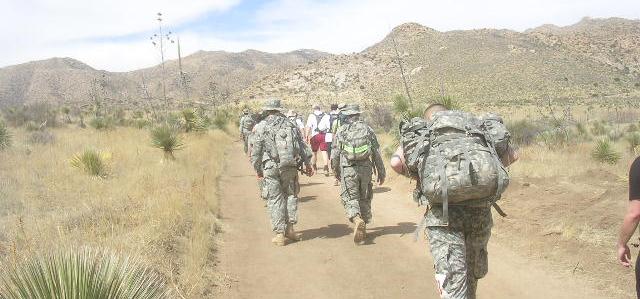 There was more of a breeze up on the mountain as the trail wound up and
down through the brush. I got to catch my breath. By that time, most of
the people running the course had already passed me, so it was just people
walking the course... passing me. A team of Canadian soldiers passed me
just past mile 13, the halfway point, where several guys stopped to change
their socks. I listened a little to music from my MP3 player, but the earphones
kept getting tangled with my hat’s chinstrap. I finally just put the music
away.
There was more of a breeze up on the mountain as the trail wound up and
down through the brush. I got to catch my breath. By that time, most of
the people running the course had already passed me, so it was just people
walking the course... passing me. A team of Canadian soldiers passed me
just past mile 13, the halfway point, where several guys stopped to change
their socks. I listened a little to music from my MP3 player, but the earphones
kept getting tangled with my hat’s chinstrap. I finally just put the music
away.
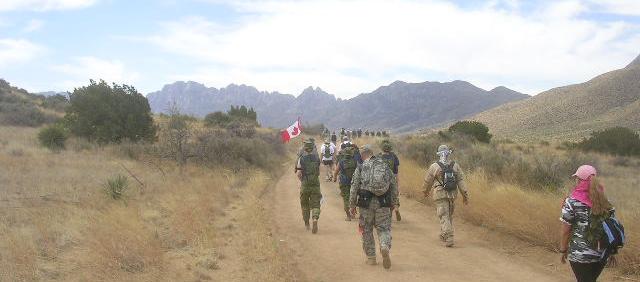 The wind picked up, but since it wasn’t in my face it didn’t bother me.
From there it was downhill to the next med station, which I made at 11:35.
I took the chance to sit down for a moment and drink a cup of foul electrolytes,
chased down with water.There was a stand selling hot dogs to marchers.
There was a line of marchers waiting to buy one. The smell was inviting,
but I had a feeling it would be a bad idea. A guy from an ROTC group munched
on a hot dog, to the disbelieving looks of his comrades. “Are you seriously
gonna eat?” one asked. “I’d throw up.” I hadn't even thought about bringing
money with me.
The wind picked up, but since it wasn’t in my face it didn’t bother me.
From there it was downhill to the next med station, which I made at 11:35.
I took the chance to sit down for a moment and drink a cup of foul electrolytes,
chased down with water.There was a stand selling hot dogs to marchers.
There was a line of marchers waiting to buy one. The smell was inviting,
but I had a feeling it would be a bad idea. A guy from an ROTC group munched
on a hot dog, to the disbelieving looks of his comrades. “Are you seriously
gonna eat?” one asked. “I’d throw up.” I hadn't even thought about bringing
money with me.
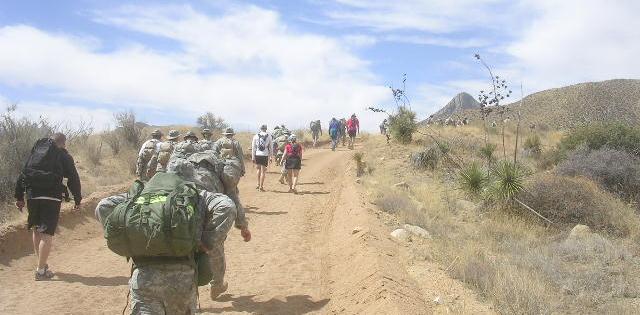 Down the path, the trail curved around the mountain. Down below, we could
see the streets and buildings of the base in the distance. “Is that the
base?” one guy in a Nike shirt asked out loud. “We’re in the home stretch
now!” A couple of veteran marchers behind me chuckled at the Nike guy.
"He hasn't seen the wall yet," one said ominously.
Down the path, the trail curved around the mountain. Down below, we could
see the streets and buildings of the base in the distance. “Is that the
base?” one guy in a Nike shirt asked out loud. “We’re in the home stretch
now!” A couple of veteran marchers behind me chuckled at the Nike guy.
"He hasn't seen the wall yet," one said ominously.
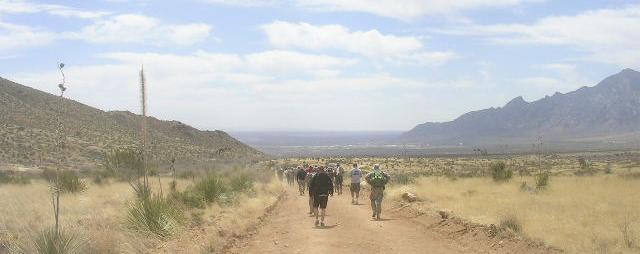 At mile 15, I rewarded myself with another peppermint. At 12:20, I got
to the next med station, where I had a cup of water and an orange slice.
Several of the veterans were sitting beside the course, shaking hands with
the marchers as they passed by. Ten minutes later, I got to the mile 16
marker. I thought I was making good time. I’d made 16 miles in five hours.
Ten to go. By then, the field had really thinned out. My feet felt
swollen inside my shoes, and every step burned with dull pain. Green and
red cactus lined the path on either side. At mile 18, a color guard carrying
a guidon marched past me. By then, I was feeling pains in my upper and
lower back, as well as my left hip. Bending over relieved some of the pain,
but I had to be careful to not straighten up too quickly. That really hurt.
Down the path was when I got passed by a pretty Air Force sergeant and
her team; she looked like actress Jessica Biel. We soon came across a bed
of sensors spread across the path. A computer beeped as we stepped over
it. I presumed it was scanning everybody’s chips, to make sure we’d really
made it this far on the march and not tried to cheat by taking a shortcut.
Up ahead was the road. We’d made it all the way around the mountain.
At mile 15, I rewarded myself with another peppermint. At 12:20, I got
to the next med station, where I had a cup of water and an orange slice.
Several of the veterans were sitting beside the course, shaking hands with
the marchers as they passed by. Ten minutes later, I got to the mile 16
marker. I thought I was making good time. I’d made 16 miles in five hours.
Ten to go. By then, the field had really thinned out. My feet felt
swollen inside my shoes, and every step burned with dull pain. Green and
red cactus lined the path on either side. At mile 18, a color guard carrying
a guidon marched past me. By then, I was feeling pains in my upper and
lower back, as well as my left hip. Bending over relieved some of the pain,
but I had to be careful to not straighten up too quickly. That really hurt.
Down the path was when I got passed by a pretty Air Force sergeant and
her team; she looked like actress Jessica Biel. We soon came across a bed
of sensors spread across the path. A computer beeped as we stepped over
it. I presumed it was scanning everybody’s chips, to make sure we’d really
made it this far on the march and not tried to cheat by taking a shortcut.
Up ahead was the road. We’d made it all the way around the mountain.
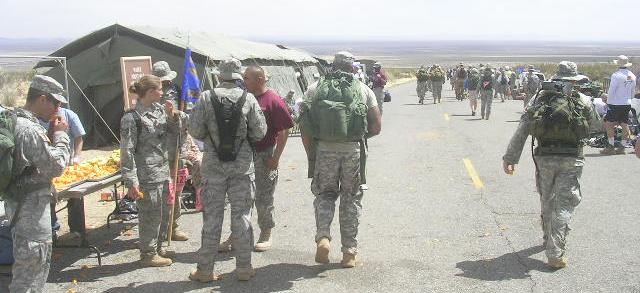 I got some water and sat down for a moment before heading back down the
road we’d climbed that morning. I noticed I was limping, favoring my left
side. When I went past the misting machines, the wind had picked up. “Almost
there!” a cheerful volunteer told me. I made it to mile 19 at 1:30. As
I passed the sign, one soldier pointed to it and said, “Only one more mile!
…And then, six more!” The soldier’s buddy was listening to music
on his Ipod. He had the volume up so loud, I could hear it, and he seemed
to march along with his own theme music. Sgt. Jessica Biel marched past
me in a brisk, confident stride.
I got some water and sat down for a moment before heading back down the
road we’d climbed that morning. I noticed I was limping, favoring my left
side. When I went past the misting machines, the wind had picked up. “Almost
there!” a cheerful volunteer told me. I made it to mile 19 at 1:30. As
I passed the sign, one soldier pointed to it and said, “Only one more mile!
…And then, six more!” The soldier’s buddy was listening to music
on his Ipod. He had the volume up so loud, I could hear it, and he seemed
to march along with his own theme music. Sgt. Jessica Biel marched past
me in a brisk, confident stride.
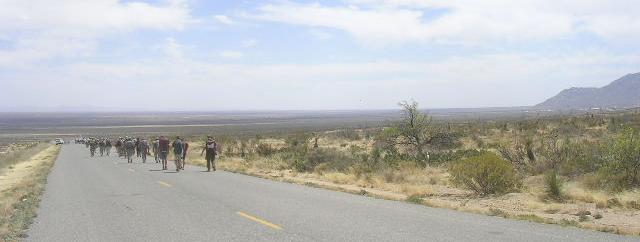 I crossed back under the overpass. At 2 PM I got to the med tent at the
bottom of the hill. I really needed to sit down for a minute. Two different
medics leaned over and asked if I was okay. I said yeah, I just needed
to sit down. “Well sure!” said one medic. “You just walked 21 miles!” I
got up and trudged down the pavement road towards the base, until the course
turned back onto a dirt road again.
I crossed back under the overpass. At 2 PM I got to the med tent at the
bottom of the hill. I really needed to sit down for a minute. Two different
medics leaned over and asked if I was okay. I said yeah, I just needed
to sit down. “Well sure!” said one medic. “You just walked 21 miles!” I
got up and trudged down the pavement road towards the base, until the course
turned back onto a dirt road again.
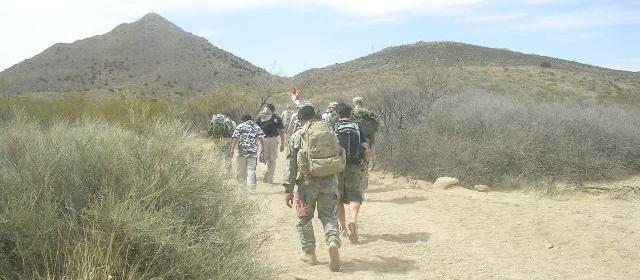 Off in the brush, that was where I got to the “Sand Pit.” For almost a
mile, the course turned into sand and loose gravel. Every step, you would
sink down to your ankles. I was holding on pretty well up until then, but
slogging through that mess just sapped the energy out of me. I had to stop
three times to catch my breath before finding solid marching ground again.
The Sand Pit was where a bunch of U.S. Marshals passed me.
Off in the brush, that was where I got to the “Sand Pit.” For almost a
mile, the course turned into sand and loose gravel. Every step, you would
sink down to your ankles. I was holding on pretty well up until then, but
slogging through that mess just sapped the energy out of me. I had to stop
three times to catch my breath before finding solid marching ground again.
The Sand Pit was where a bunch of U.S. Marshals passed me.
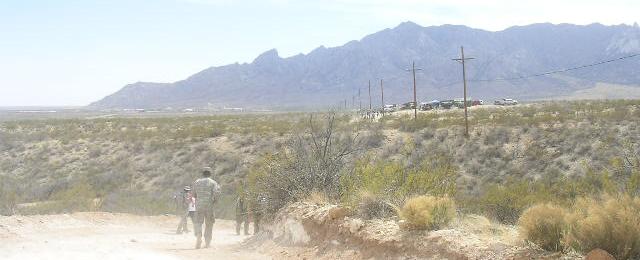 The next med station appeared on a distant hill, and it looked really welcome,
even if we had to climb a hill to get to it. I stopped and sat down when
I reached it at 2:40. My heart was racing as I sipped a cup of water. My
chest felt really tight. If I’d had shooting pains down my arms, I would’ve
thought I was having a heart attack. That was where I asked the guy next
to me to take my picture. I wanted at least one picture of me on the course.
As I left, I told him, “See you at the finish line.”
The next med station appeared on a distant hill, and it looked really welcome,
even if we had to climb a hill to get to it. I stopped and sat down when
I reached it at 2:40. My heart was racing as I sipped a cup of water. My
chest felt really tight. If I’d had shooting pains down my arms, I would’ve
thought I was having a heart attack. That was where I asked the guy next
to me to take my picture. I wanted at least one picture of me on the course.
As I left, I told him, “See you at the finish line.”
 From there, the dirt road pointed straight back to the base. The pains
in my back bent me forward, and I shuffled along through the dust. I’d
also had an annoying runny nose all day. I think I must have been allergic
to something in the air. Two guys with water packs came up alongside me.
“We’ve been following you since this morning,” one of them said. “And here
you are!” The other added, “We’ve been admiring your commitment to lack
of gear.” Well, I said, I figured they’d have water stations along the
route and medics handy. “Right,” the first one said. “What could go wrong?”
Down the path, I looked around, and there was about a hundred yards between
me and the next marcher, forward and behind me. The road was longer than
it looked. It seemed to go on forever. The wind picked up right about then,
roaring across the desert. I noticed some dark clouds building to the west,
and hoped I wouldn’t get rained on before finishing. At just after 3:05,
I made it to mile 23. Swirling dust stung my eyes. I began to pick up my
pace a little. A handful of guys passed me, carrying something odd: bagpipes.
They were the bagpipe band from opening ceremonies. Bagpipers were faster
than me! On the other hand, it takes guts to do a marathon in a kilt.
From there, the dirt road pointed straight back to the base. The pains
in my back bent me forward, and I shuffled along through the dust. I’d
also had an annoying runny nose all day. I think I must have been allergic
to something in the air. Two guys with water packs came up alongside me.
“We’ve been following you since this morning,” one of them said. “And here
you are!” The other added, “We’ve been admiring your commitment to lack
of gear.” Well, I said, I figured they’d have water stations along the
route and medics handy. “Right,” the first one said. “What could go wrong?”
Down the path, I looked around, and there was about a hundred yards between
me and the next marcher, forward and behind me. The road was longer than
it looked. It seemed to go on forever. The wind picked up right about then,
roaring across the desert. I noticed some dark clouds building to the west,
and hoped I wouldn’t get rained on before finishing. At just after 3:05,
I made it to mile 23. Swirling dust stung my eyes. I began to pick up my
pace a little. A handful of guys passed me, carrying something odd: bagpipes.
They were the bagpipe band from opening ceremonies. Bagpipers were faster
than me! On the other hand, it takes guts to do a marathon in a kilt.
It took me less than a half hour to make it to the next mile marker.
There was a med station there handing out water, and little cups of trail
mix. “Only 2.6 more miles!” the volunteers cheerful told me. I sat down
heavily in a chair next to a woman in green fatigues. “Only two miles left,”
she said as I stood on shaky legs. “Yeah, that shouldn’t kill me,” I said.
“Let’s hope not!” she replied. The straight road went on and on past mile
25. Local children had made encouraging posters and put them up along the
route. Behind me, I heard a lady marcher's cellphone chirp. She pulled
it out of her pocket with an exasperated sigh; without even answering the
call, she yelled at the phone, "No, I'm not done yet!"
Lots of marchers brought their cellphones along with them.
Soon afterward was where I hit… the wall. No, really. It was
a stone wall, built around the base housing. The route followed the wall,
and it seemed to go on and on. I quickly decided I hated that wall. I’d
never seen that wall before in my life, but I hated it. The wind picked
up, blowing dust right in my face, as if adding insult to injury.
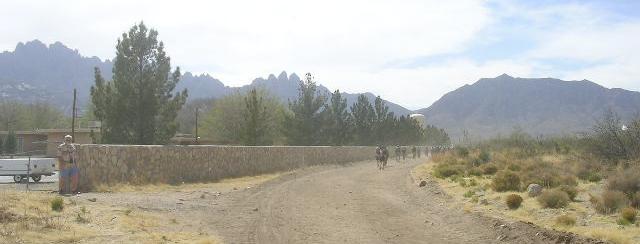 I found myself alongside a redheaded young woman in green fatigues. Her
nametag said Searcy. She said it was her fifth time to do the March, which
she admitted was a “crazy” thing to do… but, she keeps coming back and
doing it again. Officer Searcy tried to warn people resting beside the
road. If you sit too long, she said, your feet begin to swell, and then
it’s harder to get started again. It was better to keep a steady pace,
however slow it might be. The trail looped away from the wall and around
a water tower, and then around another one.
I found myself alongside a redheaded young woman in green fatigues. Her
nametag said Searcy. She said it was her fifth time to do the March, which
she admitted was a “crazy” thing to do… but, she keeps coming back and
doing it again. Officer Searcy tried to warn people resting beside the
road. If you sit too long, she said, your feet begin to swell, and then
it’s harder to get started again. It was better to keep a steady pace,
however slow it might be. The trail looped away from the wall and around
a water tower, and then around another one.
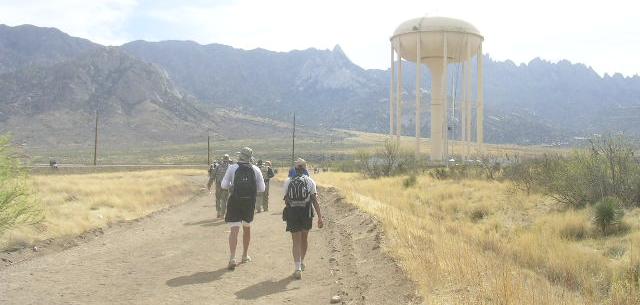 We found the last water station at mile 26. The sign seemed to mock us,
because we still had another .2 miles left to go. And, we were back
alongside the wall. Each breath was shallow. My chest felt really tight.
I thought about asking the medics to check my heart pressure when I finished.
But first, I’d have to finish.
We found the last water station at mile 26. The sign seemed to mock us,
because we still had another .2 miles left to go. And, we were back
alongside the wall. Each breath was shallow. My chest felt really tight.
I thought about asking the medics to check my heart pressure when I finished.
But first, I’d have to finish.
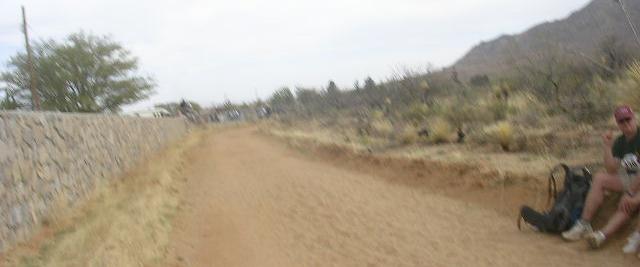 When I got to the last 200 yards, I saw people lining the route, cheering
us on. I picked up my pace. I looked back at Officer Searcy, who smiled
and told me to go on. The course pulled back onto pavement as people all
around me yelled and applauded. Of course, they might’ve been applauding
at the old, grey-bearded man who trotted past me, walking stick held high
like an Olympic torch, but it was all good. Seeing WW II vets cheering
me on was a real rush. I threw back my shoulders and held my chin high
as I marched the last few feet over the finish line. I made it!
I did the Death March!
When I got to the last 200 yards, I saw people lining the route, cheering
us on. I picked up my pace. I looked back at Officer Searcy, who smiled
and told me to go on. The course pulled back onto pavement as people all
around me yelled and applauded. Of course, they might’ve been applauding
at the old, grey-bearded man who trotted past me, walking stick held high
like an Olympic torch, but it was all good. Seeing WW II vets cheering
me on was a real rush. I threw back my shoulders and held my chin high
as I marched the last few feet over the finish line. I made it!
I did the Death March!
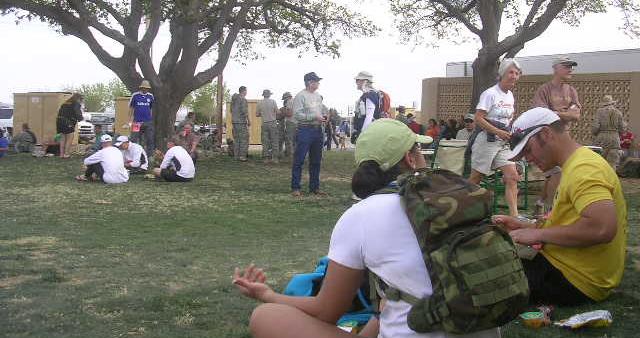 I leaned on a fence, then gulped down a cup of water and limped over to
the shade of a tent. I sat down on a folding chair for a while. I was completely
fried. I was dehydrated, sunburned and wind-blown. My legs were wobbly
and my back ached. There wasn’t a part of me that did not hurt. It felt
great. I fumbled with the safety pins holding up my bib number, because
my fingers were all stiff and swollen. I had finished too late to catch
closing ceremonies, and most of the dignataries had left, but there were
still a lot of people recovering from the March. When I caught my breath,
I wobbled over to the Officer’s Club, where a free meal was being served
for marchers: hot dogs and cheeseburgers. And cold beer! I found a shady
spot outside and managed to sit on the grass without falling over too badly.
I saw Officer Searcy walking with an older gentleman. Sgt. Jessica Biel
sat under a tree with her troops. I had not seen the brunette with the
red Camelbak since mile 8. A big gust of wind blew threw, knocking over
an overloaded trashcan. It was not yet 5 PM. I slowly made it back to my
feet and started making my way back to my camp. The wind was picking up.
Past the playground, something was hung up on a street sign. It was somebody’s
tent! Someone’s tent had been blown out of their camp and caught on a yield
sign. I walked carefully down the streets, minding my sore feet, the Sun
bright overhead.
I leaned on a fence, then gulped down a cup of water and limped over to
the shade of a tent. I sat down on a folding chair for a while. I was completely
fried. I was dehydrated, sunburned and wind-blown. My legs were wobbly
and my back ached. There wasn’t a part of me that did not hurt. It felt
great. I fumbled with the safety pins holding up my bib number, because
my fingers were all stiff and swollen. I had finished too late to catch
closing ceremonies, and most of the dignataries had left, but there were
still a lot of people recovering from the March. When I caught my breath,
I wobbled over to the Officer’s Club, where a free meal was being served
for marchers: hot dogs and cheeseburgers. And cold beer! I found a shady
spot outside and managed to sit on the grass without falling over too badly.
I saw Officer Searcy walking with an older gentleman. Sgt. Jessica Biel
sat under a tree with her troops. I had not seen the brunette with the
red Camelbak since mile 8. A big gust of wind blew threw, knocking over
an overloaded trashcan. It was not yet 5 PM. I slowly made it back to my
feet and started making my way back to my camp. The wind was picking up.
Past the playground, something was hung up on a street sign. It was somebody’s
tent! Someone’s tent had been blown out of their camp and caught on a yield
sign. I walked carefully down the streets, minding my sore feet, the Sun
bright overhead.
 It was surprise when I got to the overflow lot: most of the camps were
gone! Even the big ones had already packed up and left. The big
camp across the street with the kitchen was gone. The camps that had surrounded
the porta potties were gone. One guy left in such a hurry he left his tent
stakes still stuck in the ground. Others were busy packing up. It turns
out a lot of the marchers get a motel room in Las Cruces for the weekend.
Come the day of the March, they get up early and bring their families to
the base. After the March, their families take them back to Las Cruces
for hot baths, buffet meals, etc. That's why so many of them disappeared
immediately after the March. That seemed to be the smart way to do things.
I hit the porta potties on my way to the van. The wind kept blowing harder,
and the swaying tree branches were making me nervous. I moved Satori out
from under any trees –and just in time. It wasn’t ten minutes later I heard
a loud crack, and a huge tree limb broke away and fell heavily to
the ground not 20 feet away.
It was surprise when I got to the overflow lot: most of the camps were
gone! Even the big ones had already packed up and left. The big
camp across the street with the kitchen was gone. The camps that had surrounded
the porta potties were gone. One guy left in such a hurry he left his tent
stakes still stuck in the ground. Others were busy packing up. It turns
out a lot of the marchers get a motel room in Las Cruces for the weekend.
Come the day of the March, they get up early and bring their families to
the base. After the March, their families take them back to Las Cruces
for hot baths, buffet meals, etc. That's why so many of them disappeared
immediately after the March. That seemed to be the smart way to do things.
I hit the porta potties on my way to the van. The wind kept blowing harder,
and the swaying tree branches were making me nervous. I moved Satori out
from under any trees –and just in time. It wasn’t ten minutes later I heard
a loud crack, and a huge tree limb broke away and fell heavily to
the ground not 20 feet away.
Before leaving that morning, I put some bottles of water on the dashboard
where they’d be heated by the Sun. I peeled off my shoes and socks, and
poured the heated water into a basin, where I soaked my feet. That helped
a lot. I called home and talked to the Missus, who got to go home from
work early. I told her I finished the course and lived through it. She
asked, “Will your feet ever speak to you again?” Ma dawgs were barkin’
at me, but I figured they’d be okay. I stretched out in the back of Satori
and relaxed, munching on beef jerky, having a beer (still cold from Roswell!)
and listening to some music on my MP3 player. The wind picked up as I watched
some college students pack up their cars and leave. I later found out on
the Internet that in my division, the civilian men's light division (and
by "light," they mean not carrying a 35-pound pack), I finished
721st out of 982. It took me 8 hours, 51 minutes, and 42 seconds to go
26.2 miles.
There was something in my pocket: it was my last peppermint. I'd forgotten
all about it. Sunset came, and it wasn’t hard at all to curl up in the
dark and fall fast asleep. I did it!

 The March
The March



























